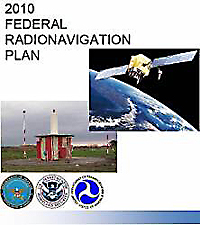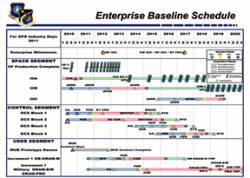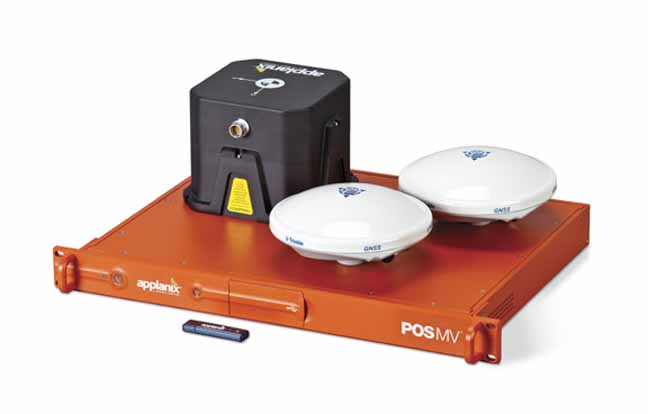Old and New: Return of the Federal Radionavigation Plan

The recent release of the 2010 Federal Radionavigation Plan (FRP) marks the passage of a recurring milestone for the U.S. positioning, navigation, and timing (PNT) community.
By Inside GNSS
The recent release of the 2010 Federal Radionavigation Plan (FRP) marks the passage of a recurring milestone for the U.S. positioning, navigation, and timing (PNT) community.
By Inside GNSS Mike Dyment, General Partner, NextGen Equipage Fund LLC
Mike Dyment, General Partner, NextGen Equipage Fund LLC» Air Traffic Control Modernization (PDF)
In between partisan confrontations around the 2011 federal budget and raising the U.S. debt limit, prospects are improving for federal legislation that would provide the Federal Aviation Administration (FAA) with a regular full-year budget for the first time since Fiscal Year 2007 — including support for completing the transition to a GNSS-driven air traffic control (ATC) system known as NextGen and a “public-private partnership” to equip aircraft with the needed avionics.
By Inside GNSS Rakon RTX7050A TCXO
Rakon RTX7050A TCXORakon Ltd. has launched two new fully integrated temperature compensated crystal oscillators (TCXOs) in its RTX-A series, designed for use in precision GNSS receivers and wireless communication devices and base stations, such as LTE femtocells, IP timing, and WiFi/WiMax.
The RTX7050A and RTX5032A (5 x 3.2 millimeters) employ an analog IC for both the oscillator and temperature compensation.
By Inside GNSS Julius Genachowski, FCC Chairman
Julius Genachowski, FCC ChairmanGPS supporters are trying to slow what appears to be a runaway LightSquared express bearing down on the civil L1 signal frequency and thwart the would-be 4G/LTE broadband cellular wholesaler’s effort shift the burden of proof and associated costs for mitigating interference onto the GNSS community.
By Inside GNSSFunny thing about the U.S. Constitution: it address the activities of government officials and agencies — including restraints on those activities — but not the activities of commercial business and individuals. The latter are left to federal, state, and local laws.
So, when the government conducts warrantless surveillance using GPS, the issue may come before the U.S. Supreme Court or state and federal judges at other levels. If private companies do it, they may end up at a congressional hearing.
By Inside GNSS
Resolution of the between Congressional Republicans and Democrats that threatened a shutdown of the federal government has clarified the picture for military GPS programs in the coming year, although prospects for the civil side remain uncertain.
On April 15, 2011, President Obama signed the Department of Defense and Full-Year Continuing Appropriations Act, 2011 (H.R. 1473, Public Law 112-10), the last in a series of government-wide funding measures for Fiscal Year 2011 (FY11).
By Inside GNSS Pace High School “Catastrophic” team, the 2010 winner
Pace High School “Catastrophic” team, the 2010 winnerTen Lego kits transformed into autonomous robotic vehicles will gather, with their high school student masters, on Saturday, May 21 at the Smithsonian for the 2011 national championship of the Institute of Navigation Mini-Urban Challenge.
It all happens from 8 a.m. to 5 p.m. in the Spark!Lab and first floor of the Lemelson Center for the Study of Invention and Innovation on the National Mall.
By Inside GNSS T-Hawk MAV. Honeywell photo
T-Hawk MAV. Honeywell photoA GPS-guided T-Hawk Micro Air Vehicle (MAV) more frequently used in combat reconnaissance missions in Iraq and Afghanistan is being used to help emergency efforts at Japan’s damaged fukushima Daiichi nuclear plant.
Weighing just 17 pounds and measuring 14 inches in diameter, the T-Hawk is a ducted-fan vertical takeoff and landing air vehicle originally developed in recent years by Honeywell Corporation under a $40-million Defense Advanced Research Projects Agency (DARPA) technology demonstration contract.
By Inside GNSS Enterprise Baseline Schedule
Enterprise Baseline ScheduleCol. Bernie Gruber, commander of the GPS Directorate since June 2010, works in a busy place.
Through its various incarnations since being established in 1974 — as Joint Program Office, Air Force Wing, and now Directorate — the GPS program at the Space and Missile Systems Center (SMC), Los Angeles Air Force Base, California, has been at the center of the action.
By Inside GNSS
On Friday (April 15, 2011) the Obama administration asked the U.S. Supreme Court to take up the question of whether prolonged police surveillance using GNSS-aided tracking of a suspect requires a search warrant under the provisions of the Fourth Amendment to the U.S. Constitution.
By Inside GNSS Applanix POS MV V5
Applanix POS MV V5Applanix has released Version 5 of the company’s POS MV (Position and Orientation System for Marine Vessels), the next generation of its georeferencing and motion compensation system for hydrographic surveying.
By Inside GNSS Geneq SXBlue IIIL
Geneq SXBlue IIILGeneq Inc., a Montreal, Quebec, Canada, manufacturer, has introduced two new GPS products.
The SXBlue III-L is a compact GPS L1/L2 receiver in the world designed for use with OmniSTAR’s HP service to attain decimeter accuracy worldwide. Targeted at GIS mapping/surveying applications, the receiver measures 14 x 8 x 5.6 centimeters (5.57 x 3.15 x 2.22 inches) and weighs 517 grams (1.14 pounds) including battery.
By Inside GNSS
A number of user conferences for customers of Hexagon AB’s precise measurement brands and products will be combined in the Swedish corporation’s first international conference this summer.
It will take place at Orlando World Center Marriott Resort in Orlando, Florida from June 6 through June 9, 2011.
The theme is "Building a Smarter World," and will include 200 technical and training sessions and an industry exhibition.
By Inside GNSS